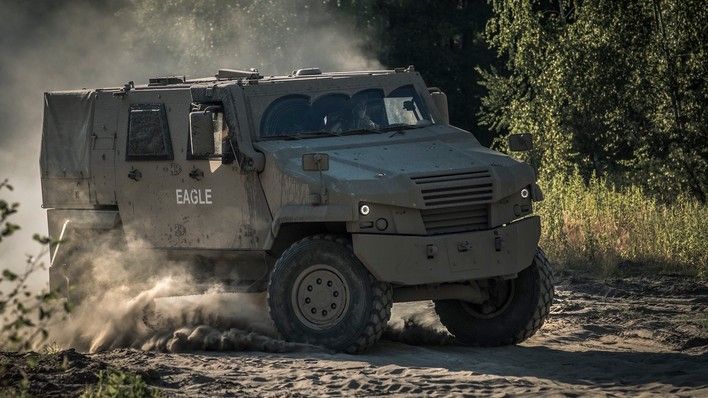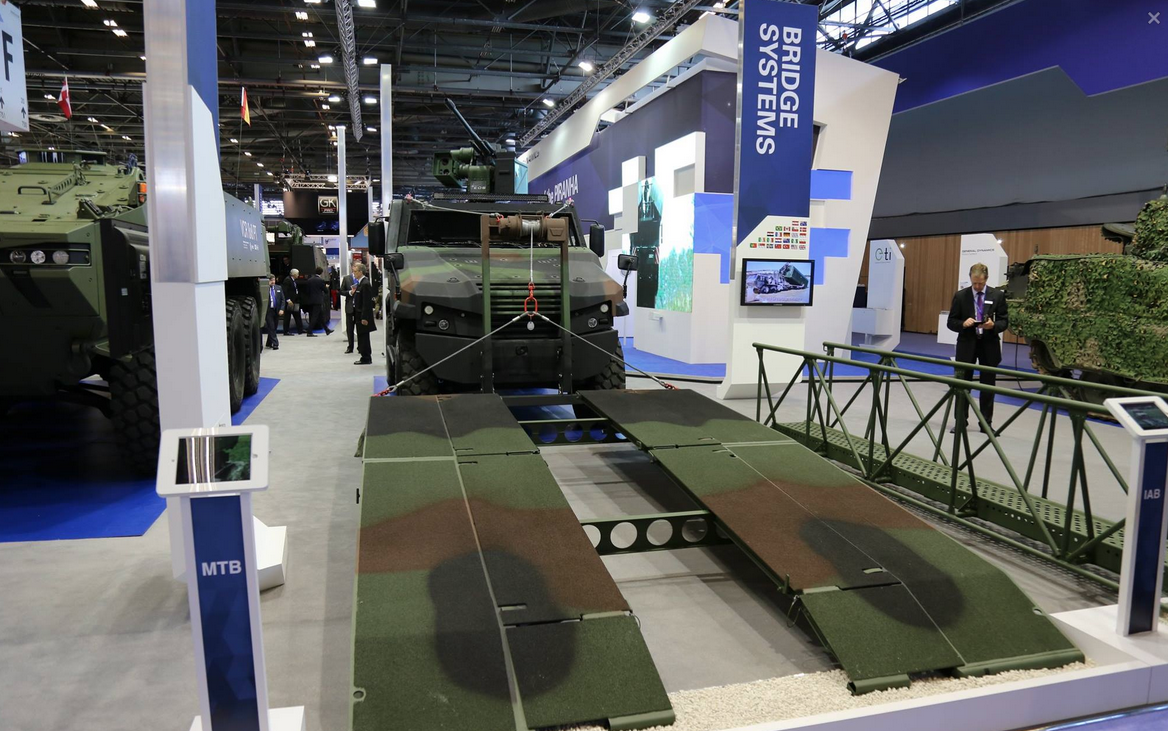EAGLE Multi-Role Vehicle Proposed for Polish Army

The EAGLE V multi-purpose vehicle remains one of the proposals offered within the framework of the Polish Pegaz programme. It is being manufactured by the General Dynamics European Land Systems Company. Similar vehicles have already been purchased by the Danish and German armed forces. Should Poland select the EAGLE platform within the framework of its Pegaz procurement, the manufacturing process could potentially be established domestically.
WPWS platform procurement (Wielozadaniowy Pojazd Wojsk Specjalnych – Multi-Purpose Special Operations Component Vehicle) programme is being planned in Poland at the moment. The programme in question is also known under the name Pegaz. According to the preliminary assumptions of the above procurement, the newly acquired vehicles would be operated by the Special Operations Forces, Military Police and, in a longer run, by the land component in general. In case of the special operations and military police the vehicles would be used in patrol, intervention, counterterrorism and reconnaissance scenarios.
When it comes to the land forces, on the other hand, the platform would constitute an effective fighting system used for the purpose of patrol, reconnaissance, escort or transport operations. Specialized variants of the vehicle, including command, MEDEVAC or tank-destroyer versions, are also expected to be acquired. The multi-purpose 4×4 platform is also going to be used, within the scope of the Homar rocket artillery programme, as a lower-level command asset. The Armament Inspectorate of the Polish MoD recently informed us that fusion of the two programmes mentioned above is being considered (Pegaz and Homar), for the sake of platform unification.
EAGLE vehicle is one of the multi-purpose platforms, offered within the scope of the Pegaz procurement programme pursued by the Polish military. Its story dates far back, to the times when the Swiss MOWAG company (taken over by General Dynamics European Land Systems) decided to create a multi-purpose 4×4 armoured vehicle. To shorten the time required to develop such platform and to make the process cost-effective, adaptation of a proven solution took place – US-made HMMWV platform was used by the Swiss, for an entirely new purpose. This is how the universal EAGLE I platform was born. The design featured modern solutions in the domain of crew safety. It was highly mobile across a variety of terrain conditions. Furthermore, the vehicle was designed to be modular, which makes it easy to adapt it to a variety of operational contexts.
Later on, newer EAGLE II/III/IV variants were developed, on the basis of the experience gathered during the operational use of their predecessors. Analysis of requirements defined by a number of armed forces also contributed to evolution of the vehicle. EAGLE V is the latest version, and this very version is being offered in the Polish tender.
The latest variant can be defined as a multi-purpose modular armoured vehicle, based on 4×4 and 6×6 chassis. Both versions also feature a unified suspension and drivetrain. Thanks to the above, the commonality between the platforms is as high as 70%. This makes it possible to use the vehicle for a wide variety of purposes. The adopted approach also simplifies the manufacturing process and diminishes the cost required to be covered, when acquiring and maintaining the vehicle, also within the scope of driver and crew training effort.

EAGLE V vehicles have already been acquired by the German Armed Forces or by the Denmark. In case of the Bundeswehr, EAGLE V plays a role of a command platform. The Germans also use the older EAGLE IV variant. These vehicles, in large quantities, were operated in Afghanistan. To a great extent they have been unified with the Duro III/PAK platform.
EAGLE V has total permissible mass of 10 tonnes for the 4×4 variant and 15 tonnes for the 6×6 version. The vehicles can carry payloads of 3.3 and more than 5 tonnes respectively, while the EAGLE V 6×6 cabin volume exceeds 16 cubic metres. The vehicle is capable of attaining top speed of 110 kilometres per hour on hardened surfaces, with a range of 700 kilometres. EAGLE V may go over 500 mm high vertical obstacles, wade through 1200 mm deep water (up to 1500 mm with preparation) and has a turning radius of 15 meters. The ground clearance is 440 mm, with approach angle of 45 and descend angle of 51. De-Dion suspension facilitates driving the platform off the roads and going over slopes of up to 60% inclination.
The 4×4 vehicle carries up to 5 soldiers, the 6×6 variant may carry up to 14 soldiers (base vehicle features four side doors). The soldiers use seats that reduce the g-loads caused by IED or mine explosions under the vehicle bottom or wheel.
4×4 vehicle is 5400 mm long, 2280 mm wide and 2500 mm high, with the 6×6 variant being 7000 mm long. The lower, V-shaped portion of the hull enhances the effectiveness of protection, also covering the frame and drive-shafts. Protection level offered by the vehicle depends on the variant of the modular armour selected by the customer.
EAGLE V may also feature an NBC protection system or automatic fire extinguisher for the cabin and for the engine compartment. Saab Land Electronics LEDS 150 active protection system was tested with the Eagles. It is also possible to adopt or install other similar light active protection suite with the platform. LASSO (Light Armour System against Shaped Ordnance) delivered by RUAG Defence is another system dedicated for the EAGLEs.
The vehicle has a 6-cylinder Cummins ISB6.7 E3 6.7 litre diesel engine, with a power output of 245 HP (285 HP engine being an option). The engine attains torque of 925 Nm (970 Nm – option) and is compliant with the Euro III norm. It has been coupled with the 5-speed Allison 2500 SP automatic gearbox. The drive system makes it possible to attain power-to-weight ratio of 25 HP per tonne. Both the engine, as well as the gearbox, are quite common on the civil market, which diminishes the cost of operational use pertaining to these components. Eagle uses 365/80 R20 run-flat tyres.
A number of armament solutions may be integrated onto the platform, including remote control or manned turret systems. The turrets may be fitted with .308 or .50-cal machine guns or 40 mm automatic grenade launchers. There is also an option to have side-mounted armament fitted onto the vehicle. Alternatively, the user may also integrate a heavier turret with the EAGLE, featuring an automatic cannon, a ATGM launcher or a MANPADS-class system.
The standard equipment includes the ABS, A/C system and onboard computer monitoring the vehicle status, along with reversing camera, front window and mirrors heating system. Optionally, the vehicle could also be integrated with a variety of BMS solutions, slat armour, extra batteries and other similar elements. Moreover, potential installation of extra hatches, cameras and protection systems, optronic systems, radar masts and other equipment has also been included on the list of the possible optional extras, all is arranged in line with the needs of the potential customer.
Both 6×6 and 4×4 versions remain available. The vehicles may be used in patrol, reconnaissance and armament carrier roles. Certain options have also been developed with the special forces in mind. Command vehicle, ambulance and logistical versions are also available, for instance Eagle may be used to carry the GDELS Medium Trackway Bridge – assault bridge that may become an integral element of the forward operating groups.
GDELS is also offering spares, equipment packages, fittings and a number of maintenance support options. Here one should note that operational use forms 70-80% of the lifecycle cost – counted from procurement to withdrawal. The acquisition is contained in 10 to 15% of the whole lifetime cost.
For the sake of supporting its customers in the future, GDELS has established ILS (Integrated Logistics Support) department located at the facility in Kreuzlingen. The above department makes it possible to properly develop the supply chain, so that it meets the requirements of any user, which consequently diminishes the risk and total cost of use. EAGLE V platforms are being manufactured now at the facility located in Kreuzlingen, Switzerland. However, the assembly process is taking place in Kaisenslautern and Sembach in Germany (for Deutsches Heer).
In Poland, EAGLE made its debut (in IV variant) during the Kielce MSPO 2007 salon. Back then the vehicle was marketed by MOWAG GmbH. Back in 2015 a dynamic display of the vehicle’s capabilities took place at the Military Institute of Armament Technology. It was also tested by the Special Operations component. Last year, during the MSPO event, two EAGLE vehicles were being presented. Both were based on a 4×4 chassis. One was fitted with an armament module featuring a machine gun, an ATGM launcher and MTB bridge. This configuration was presented by GDELS. The second platform was showcased by Rosomak S.A. It was fitted with a double Spike-LR launcher and a remote control armament module.
The manufacturer assures that should Eagle be selected within the scope of the Pegaz programme, the vehicle could be manufactured domestically. There is also a chance to domestically develop specialized versions tailored to the specific requirements defined by the Polish military or other potential users, including uniformed services.
August Żywczyk
